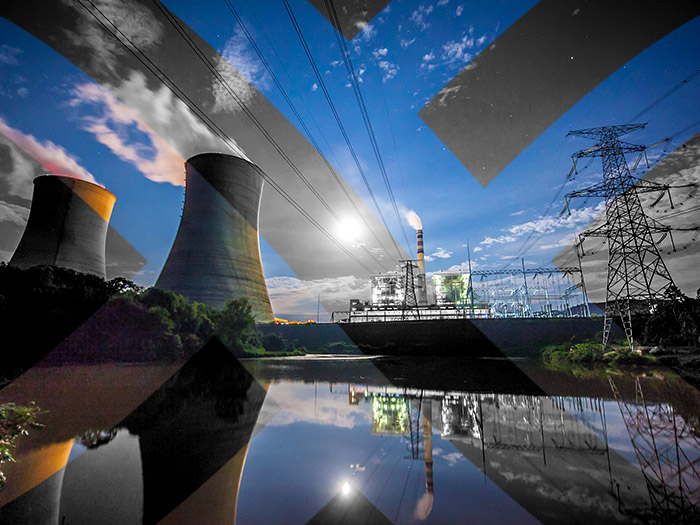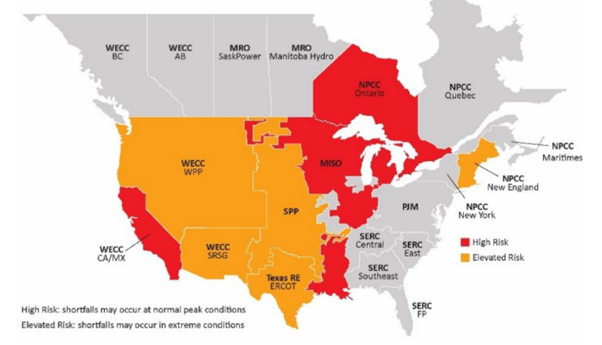Insights
better business decisions
Posted 3 years ago | 4 minute read

California and the Midwest face “high risk” of electricity shortages in the next five years
The electricity grid is being pushed to the breaking point and parts of the United States are at “high risk” for energy shortages in the period from 2023-27.
In its latest Long-term Reliability Assessment, published on December 15th, the North American Electric Reliability Corporation (NERC) said that the grid is being challenged as it goes through an unprecedented transformation from fossil fuel-based energy to renewable sources of energy. Areas identified at “high risk” for energy shortfalls at “normal peak conditions” included California, Ontario, parts of the Midwest and parts of the South Central United States.
Risk Area Summary 2023–2027

Source: NERC
In the Midcontinent Independent System Operator (MISO) area, the previously-reported reserve margin shortfall has advanced by one year, resulting in a 1,300MW capacity deficit for the summer of 2023. The projected shortfall continues an accelerating trend seen since 2020 as older coal, nuclear, and natural gas generation exit the system faster than replacement resources are connecting.
Ontario also continues to project a reserve margin shortfall in 2025 and beyond. The capacity deficit of 1,700MW is driven by generation retirements and lengthy planned outages at nuclear units undergoing refurbishment.
Resource additions in the California area are alleviating capacity risks, but energy risks persist. Planned reserve margins meet annual reserve margin targets for the duration of the 10‐year horizon. But, overall variability in both the resource mix and demand profile contributes to shortfall risk periods, mainly in summer months around sunset, when expected supplies are not sufficient to meet the demand.
Much of the rest of the Midwest and the rest of the Western part of the United States are at “elevated risk” (yellow on the map), which means shortfalls may occur in extreme conditions, like during severe weather or hot spells where everyone is running air conditioners.
In the West—CA/MX, Western Power Pool (WPP), and the Southwest Reserve Sharing Group (SRSG)—have increasing demand and resource mix variability. In normal conditions, the expected demand and resource variability is balanced across the area as excess supply from one part of the system is delivered to areas where demand is higher than supply. However, more extreme summer temperatures that stress large portions of the Interconnection reduce the availability of excess supply for transfer while also reducing the transmission network’s ability to transfer the excess.
Reliability during extreme winter weather remains a concern in Texas. ERCOT’s winter peak load varies as much as 12.5% between the coldest temperatures of an average year and a more extreme year as might be experienced once per decade. A high number of forced outages of the thermal and wind generation fleet have been an issue in severe winter weather. Improved generator availability resulting from winter preparedness programs and reforms implemented by Texas regulators, ERCOT, and generator owners since February 2021 are expected to reduce the risk that electricity supplies will be insufficient during a severe winter storm.
SPP is exposed to energy risks in ways that are similar to both Texas and the U.S. West. Severe weather in SPP is likely to cause high generator outages and poses a risk to natural gas fuel supplies. In addition, the penetration of wind generation makes the resource mix variable and exposed to insufficient energy during low wind periods.
In New England, limited natural gas infrastructure can impact winter reliability due to increased heating demand and the potential for supply disruptions to generators. Liquefied natural gas facilities and sufficient generators with stored backup fuels are critical to electric reliability
GridBeyond SVP North America Wayne Muncaster said:
“We are living in extraordinary times. Increasing awareness of climate change is pushing utilities to phase out fossil fuel-based sources of energy that generate carbon emissions. Renewables like wind and solar don’t contribute to climate change, but have periods where they don’t generate any energy.
“Managing the pace of our generation resource mix changes to ensure we have enough energy and essential services are an absolute necessity. We need to work with the entire energy system to make sure we’re managing that and that as renewables penetration increases so does the level of flexible assets able to ramp up supply or reduce demand to ensure system balance.”

Energy in crisis
In this white paper, we shine a light on the cause behind the energy crisis in the UK and examine whether the USA is following a similar path.
Learn more





